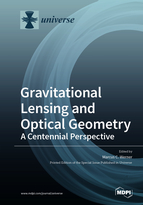Gravitational Lensing and Optical Geometry: A Centennial Perspective
A special issue of Universe (ISSN 2218-1997).
Deadline for manuscript submissions: closed (31 March 2020) | Viewed by 19329
Special Issue Editor
Special Issue Information
Dear Colleagues,
The year 2019 sees the centenary of Eddington's eclipse expeditions and the corroboration of Einstein's general relativity by gravitational lensing. To mark the occasion, you are cordially invited to contribute to this Special Issue dedicated to theoretical aspects of strong gravitational lensing. A variety of mathematical approaches have been applied to study this effect, both in 3-space and in spacetime. In particular, we will consider the following:
- Mathematical properties of the standard thin lens approximation, for instance image multiplicity and topology; complex formalism and lensing invariants;
- Optical geometry, both Riemannian for static spacetimes, and Randers–Finsler for stationary spacetimes; the Gauss–Bonnet method and related approaches;
- Lensing in the spacetime of general relativity and of modified and higher-dimensional theories, for instance properties of photon spheres and rings; black hole shadows;
Contributions discussing such lensing properties for gravitational waves will be appreciated as well. Moreover, historical surveys related to this topic are also welcome.
Thank you in advance for your consideration.
With best regards,
Dr. Marcus Werner
Guest Editor
Manuscript Submission Information
Manuscripts should be submitted online at www.mdpi.com by registering and logging in to this website. Once you are registered, click here to go to the submission form. Manuscripts can be submitted until the deadline. All submissions that pass pre-check are peer-reviewed. Accepted papers will be published continuously in the journal (as soon as accepted) and will be listed together on the special issue website. Research articles, review articles as well as short communications are invited. For planned papers, a title and short abstract (about 100 words) can be sent to the Editorial Office for announcement on this website.
Submitted manuscripts should not have been published previously, nor be under consideration for publication elsewhere (except conference proceedings papers). All manuscripts are thoroughly refereed through a single-blind peer-review process. A guide for authors and other relevant information for submission of manuscripts is available on the Instructions for Authors page. Universe is an international peer-reviewed open access monthly journal published by MDPI.
Please visit the Instructions for Authors page before submitting a manuscript. Submitted papers should be well formatted and use good English. Authors may use MDPI's English editing service prior to publication or during author revisions.
Keywords
- Gravitational lensing
- Optical geometry
- General relativity
- Modified gravity theories






